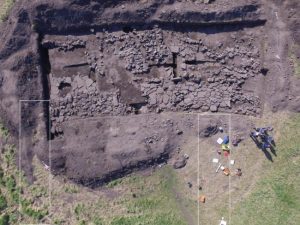Remains of possibly the largest Anglo-Saxon building were revealed during excavations in Globe Field, Aberlady in Scotland. The foundations of the structure which might have been a monastery or even a royal home date back 1200 years. The team from Aberlady Conservation and History Society and AOC Archaeology Group, aided by 350 pupils from schools in East Lothian over the excavation period, set the date by analysis of the a animal bone found at the site, which dates back between the 7th and 9th century. Aberlady in that time was on a pilgrimage route between Iona and Holy Island.

The result of radiocarbon dating the bone confirms the context of the building which is from Anglo-Saxon times. The structure measures 40 x 20 metres. The fieldwork started after the largest concentration of Anglo-Saxon metal objects to be found in Scotland were discovered in the field. The dig unearthed evidence of a large structure, with the stone foundation of a wall along its short end. The unearthed area contains laid paving, with an open “pit” area. The site is currently an ancient scheduled monument and further work is planned after discussions with Historic Environment Scotland.
(after East Lothian Courier)